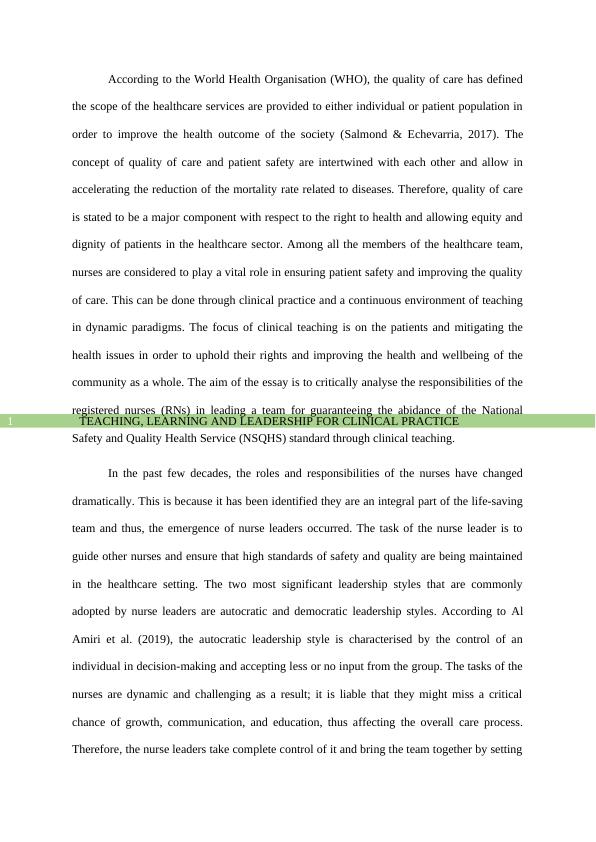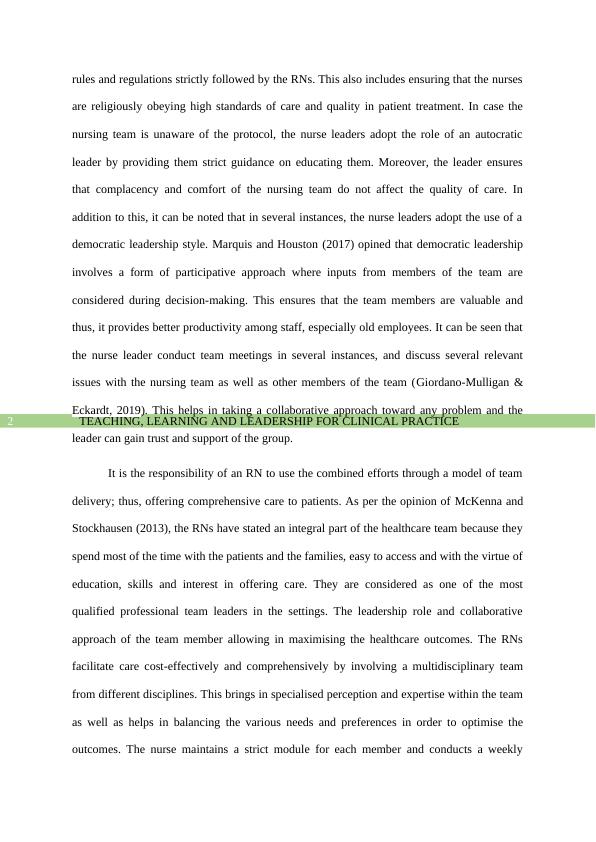Teaching Learning And Leadership For Clinical
Evaluation criteria for assessing the structure and content knowledge of an essay
10 Pages2922 Words21 Views
Added on 2022-08-27
Teaching Learning And Leadership For Clinical
Evaluation criteria for assessing the structure and content knowledge of an essay
Added on 2022-08-27
ShareRelated Documents
Running head: TEACHING, LEARNING AND LEADERSHIP FOR CLINICAL
PRACTICE
TEACHING, LEARNING AND LEADERSHIP FOR CLINICAL PRACTICE
Name of the Student:
Name of the University:
Author’s Note:
PRACTICE
TEACHING, LEARNING AND LEADERSHIP FOR CLINICAL PRACTICE
Name of the Student:
Name of the University:
Author’s Note:

TEACHING, LEARNING AND LEADERSHIP FOR CLINICAL PRACTICE1
According to the World Health Organisation (WHO), the quality of care has defined
the scope of the healthcare services are provided to either individual or patient population in
order to improve the health outcome of the society (Salmond & Echevarria, 2017). The
concept of quality of care and patient safety are intertwined with each other and allow in
accelerating the reduction of the mortality rate related to diseases. Therefore, quality of care
is stated to be a major component with respect to the right to health and allowing equity and
dignity of patients in the healthcare sector. Among all the members of the healthcare team,
nurses are considered to play a vital role in ensuring patient safety and improving the quality
of care. This can be done through clinical practice and a continuous environment of teaching
in dynamic paradigms. The focus of clinical teaching is on the patients and mitigating the
health issues in order to uphold their rights and improving the health and wellbeing of the
community as a whole. The aim of the essay is to critically analyse the responsibilities of the
registered nurses (RNs) in leading a team for guaranteeing the abidance of the National
Safety and Quality Health Service (NSQHS) standard through clinical teaching.
In the past few decades, the roles and responsibilities of the nurses have changed
dramatically. This is because it has been identified they are an integral part of the life-saving
team and thus, the emergence of nurse leaders occurred. The task of the nurse leader is to
guide other nurses and ensure that high standards of safety and quality are being maintained
in the healthcare setting. The two most significant leadership styles that are commonly
adopted by nurse leaders are autocratic and democratic leadership styles. According to Al
Amiri et al. (2019), the autocratic leadership style is characterised by the control of an
individual in decision-making and accepting less or no input from the group. The tasks of the
nurses are dynamic and challenging as a result; it is liable that they might miss a critical
chance of growth, communication, and education, thus affecting the overall care process.
Therefore, the nurse leaders take complete control of it and bring the team together by setting
According to the World Health Organisation (WHO), the quality of care has defined
the scope of the healthcare services are provided to either individual or patient population in
order to improve the health outcome of the society (Salmond & Echevarria, 2017). The
concept of quality of care and patient safety are intertwined with each other and allow in
accelerating the reduction of the mortality rate related to diseases. Therefore, quality of care
is stated to be a major component with respect to the right to health and allowing equity and
dignity of patients in the healthcare sector. Among all the members of the healthcare team,
nurses are considered to play a vital role in ensuring patient safety and improving the quality
of care. This can be done through clinical practice and a continuous environment of teaching
in dynamic paradigms. The focus of clinical teaching is on the patients and mitigating the
health issues in order to uphold their rights and improving the health and wellbeing of the
community as a whole. The aim of the essay is to critically analyse the responsibilities of the
registered nurses (RNs) in leading a team for guaranteeing the abidance of the National
Safety and Quality Health Service (NSQHS) standard through clinical teaching.
In the past few decades, the roles and responsibilities of the nurses have changed
dramatically. This is because it has been identified they are an integral part of the life-saving
team and thus, the emergence of nurse leaders occurred. The task of the nurse leader is to
guide other nurses and ensure that high standards of safety and quality are being maintained
in the healthcare setting. The two most significant leadership styles that are commonly
adopted by nurse leaders are autocratic and democratic leadership styles. According to Al
Amiri et al. (2019), the autocratic leadership style is characterised by the control of an
individual in decision-making and accepting less or no input from the group. The tasks of the
nurses are dynamic and challenging as a result; it is liable that they might miss a critical
chance of growth, communication, and education, thus affecting the overall care process.
Therefore, the nurse leaders take complete control of it and bring the team together by setting

TEACHING, LEARNING AND LEADERSHIP FOR CLINICAL PRACTICE2
rules and regulations strictly followed by the RNs. This also includes ensuring that the nurses
are religiously obeying high standards of care and quality in patient treatment. In case the
nursing team is unaware of the protocol, the nurse leaders adopt the role of an autocratic
leader by providing them strict guidance on educating them. Moreover, the leader ensures
that complacency and comfort of the nursing team do not affect the quality of care. In
addition to this, it can be noted that in several instances, the nurse leaders adopt the use of a
democratic leadership style. Marquis and Houston (2017) opined that democratic leadership
involves a form of participative approach where inputs from members of the team are
considered during decision-making. This ensures that the team members are valuable and
thus, it provides better productivity among staff, especially old employees. It can be seen that
the nurse leader conduct team meetings in several instances, and discuss several relevant
issues with the nursing team as well as other members of the team (Giordano-Mulligan &
Eckardt, 2019). This helps in taking a collaborative approach toward any problem and the
leader can gain trust and support of the group.
It is the responsibility of an RN to use the combined efforts through a model of team
delivery; thus, offering comprehensive care to patients. As per the opinion of McKenna and
Stockhausen (2013), the RNs have stated an integral part of the healthcare team because they
spend most of the time with the patients and the families, easy to access and with the virtue of
education, skills and interest in offering care. They are considered as one of the most
qualified professional team leaders in the settings. The leadership role and collaborative
approach of the team member allowing in maximising the healthcare outcomes. The RNs
facilitate care cost-effectively and comprehensively by involving a multidisciplinary team
from different disciplines. This brings in specialised perception and expertise within the team
as well as helps in balancing the various needs and preferences in order to optimise the
outcomes. The nurse maintains a strict module for each member and conducts a weekly
rules and regulations strictly followed by the RNs. This also includes ensuring that the nurses
are religiously obeying high standards of care and quality in patient treatment. In case the
nursing team is unaware of the protocol, the nurse leaders adopt the role of an autocratic
leader by providing them strict guidance on educating them. Moreover, the leader ensures
that complacency and comfort of the nursing team do not affect the quality of care. In
addition to this, it can be noted that in several instances, the nurse leaders adopt the use of a
democratic leadership style. Marquis and Houston (2017) opined that democratic leadership
involves a form of participative approach where inputs from members of the team are
considered during decision-making. This ensures that the team members are valuable and
thus, it provides better productivity among staff, especially old employees. It can be seen that
the nurse leader conduct team meetings in several instances, and discuss several relevant
issues with the nursing team as well as other members of the team (Giordano-Mulligan &
Eckardt, 2019). This helps in taking a collaborative approach toward any problem and the
leader can gain trust and support of the group.
It is the responsibility of an RN to use the combined efforts through a model of team
delivery; thus, offering comprehensive care to patients. As per the opinion of McKenna and
Stockhausen (2013), the RNs have stated an integral part of the healthcare team because they
spend most of the time with the patients and the families, easy to access and with the virtue of
education, skills and interest in offering care. They are considered as one of the most
qualified professional team leaders in the settings. The leadership role and collaborative
approach of the team member allowing in maximising the healthcare outcomes. The RNs
facilitate care cost-effectively and comprehensively by involving a multidisciplinary team
from different disciplines. This brings in specialised perception and expertise within the team
as well as helps in balancing the various needs and preferences in order to optimise the
outcomes. The nurse maintains a strict module for each member and conducts a weekly

End of preview
Want to access all the pages? Upload your documents or become a member.
Related Documents
Registered Nurse Responsibilities in Leading a Team for NSQHS Standardslg...
|8
|2989
|53
Communication for Safetylg...
|13
|3004
|24
Teaching, Learning & Leadershiplg...
|13
|2600
|19
Leadership Styles for Nursing Professionalslg...
|11
|3090
|21
Registered Nurses Responsibilities in Leading a Team for NSQHSlg...
|10
|2904
|46
Leadership in a Nursing Team | Reportlg...
|9
|3179
|17
